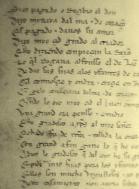Back The Author and the Manuscript
The Author
Although this is an anonymous work, an analysis of the preserved text shows that it belongs to a learned author who had an accurate knowledge of the law in force at the end of the 12th and beginning of the 13th centuries, and that he was familiar with the area around Burgos. Different theories have been put forward on his identity: it has been said he was a minstrel from Medinaceli, or one from San Esteban de Gormaz, that he was a poet from the Jiloca or Jalón river valleys and even that he was Jerome of Périgord.
In May of 1245 by the Julian calendar (1207 A.D.) an abbot who is identified simply as Pedro finished copying a manuscript of almost four thousand verses. In the conclusion he availed himself of the opportunity to request, in the ingrained tradition of mediaeval scribes, that he be given something in return: "quien escrivió este livro, dél[e] Dios paraíso.¡Amén! Per Abbat le escrivió en el mes de mayo, en era de M e CC e XLV años". ("Whosoever wrote this book, may God grant him paradise. Amen! Abbot Pedro wrote this in the month of May in the year of our Lord 1207.)
Abbot Pedro's copy contained an account of the life of Rodrigo Díaz de Vivar. This work, like so many coeval ones, lacked a title but would much later become known as the Song of My Cid or the Poem of My Cid. Abbot Pedro had copied, therefore, an earlier text whose date of authorship is still open to debate.
In the Middle Ages "to write" merely meant "to be the copyist". For what we understand today as the author it would have had to say "composed" or "made". This invalidates the theory of Colin Smith that the author was the Abbot Pedro.
The Manuscript

There is only one copy in existence and it is currently housed in the National Library (Biblioteca Nacional) in Madrid. It is a volume of 74 thick parchment sheets, three of which are missing, one from the beginning and two between pages 47/48 and 69/70. A further two sheets serve as flyleaves. Many of the pages have stains from the reagents that were utilized since the 16th century to facilitate the reading of what had probably faded. The binding of the tome dates from the 15th century. It is made of wood covered in dressed sheepskin leather with stamped ornamental scrolls.
The manuscript is a continuous text without any separation between the songs, or spacing between the verses. These always begin with a capital letter.